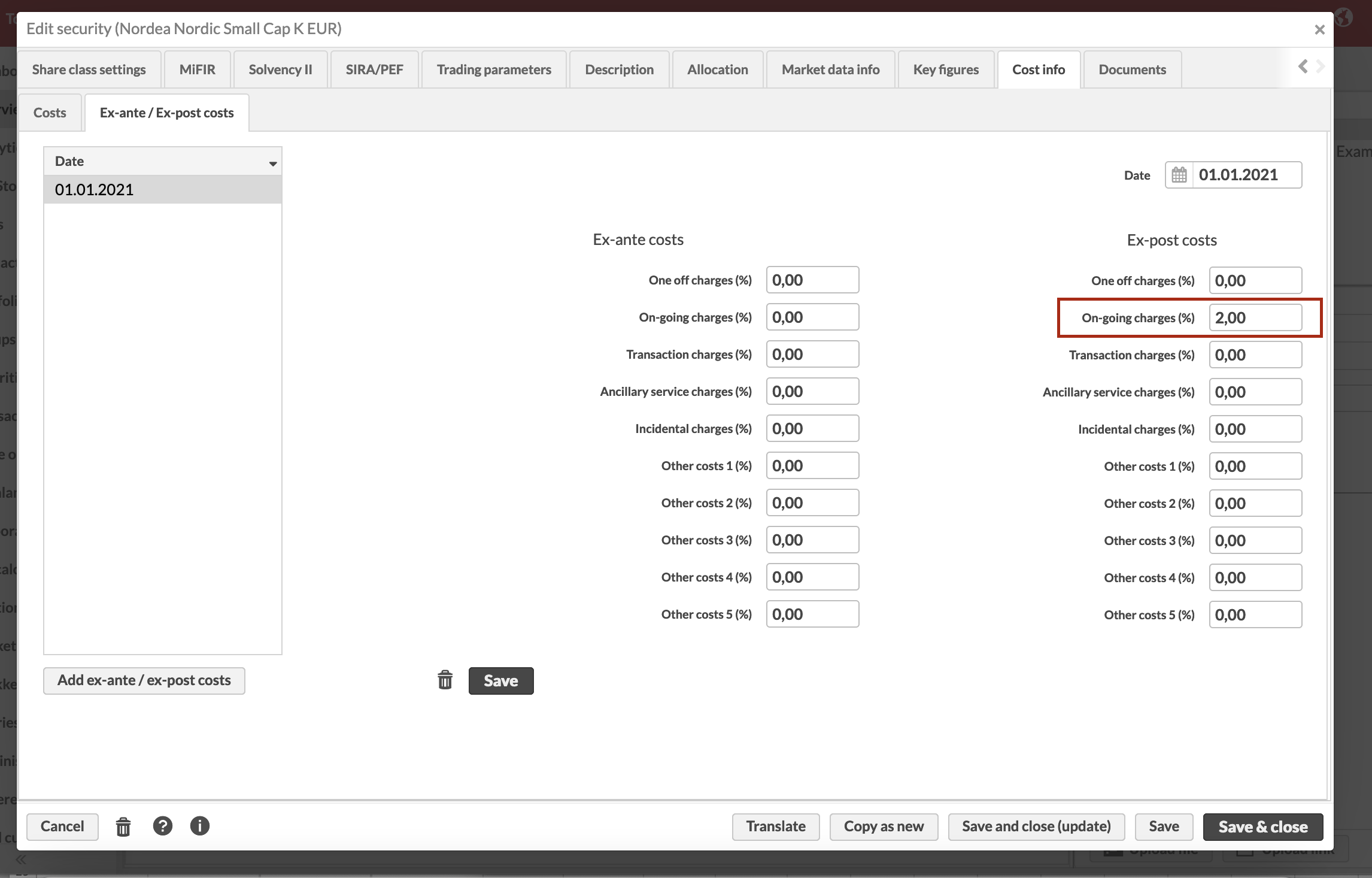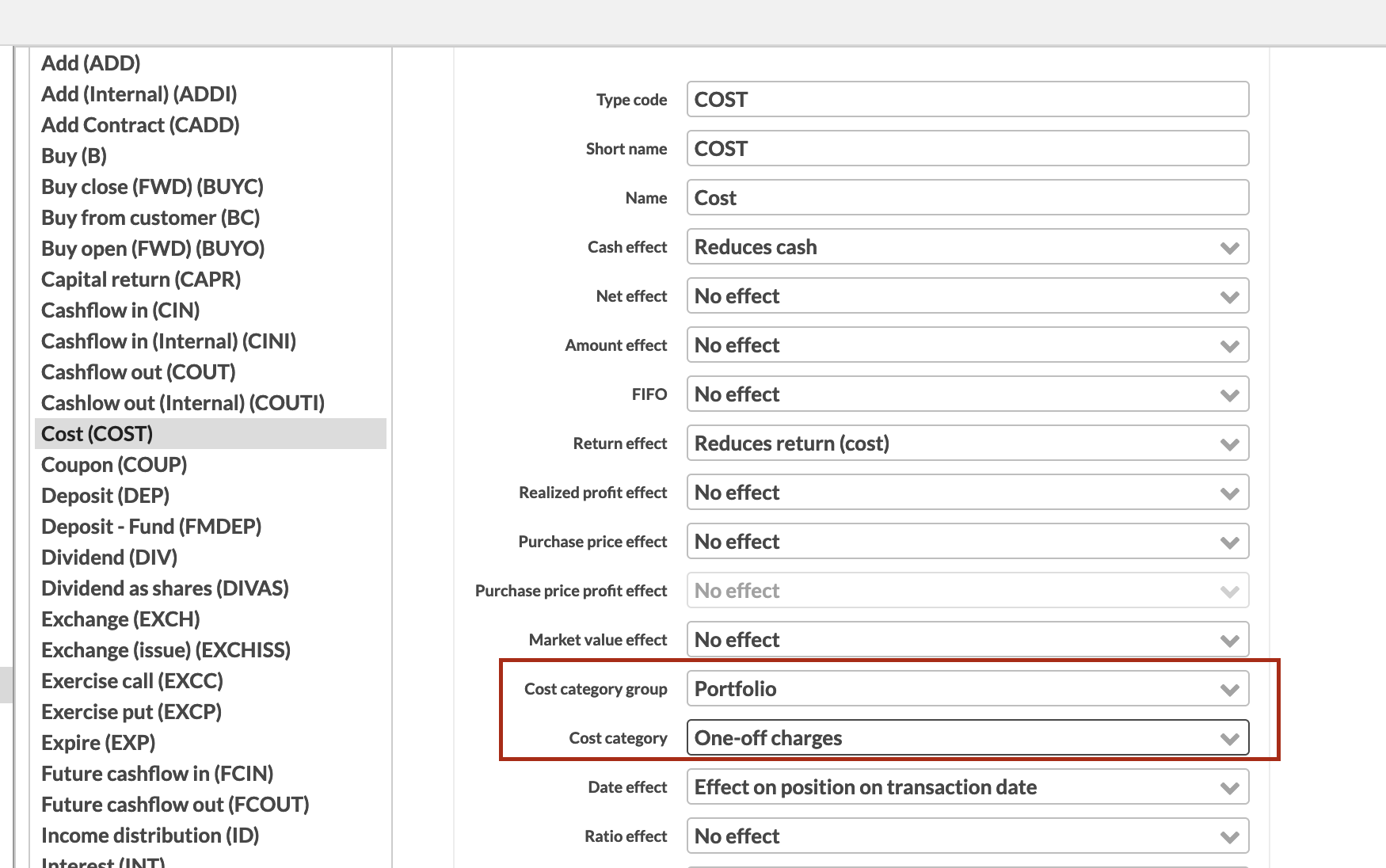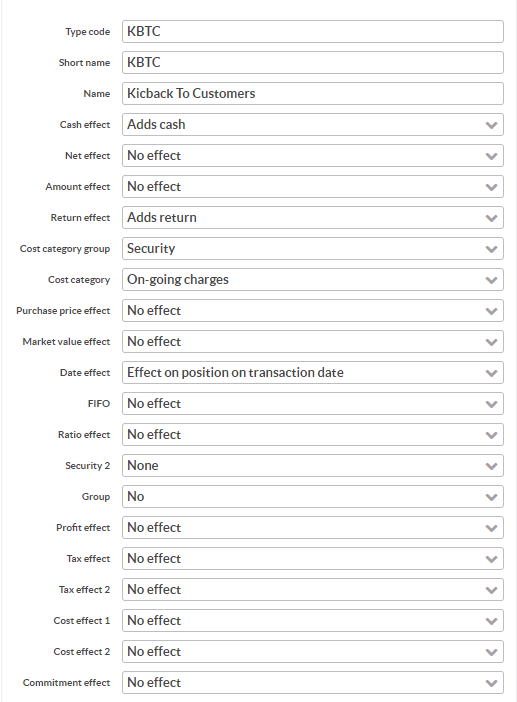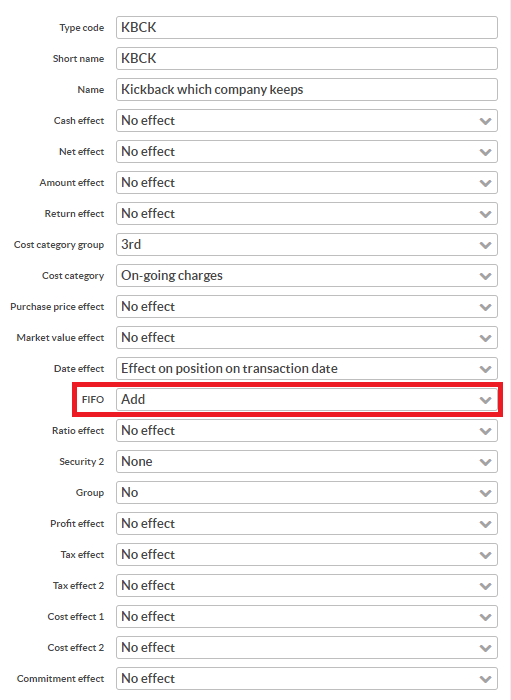Create ex-post costs and charges
The FA Platform provides you with a report showing the breakdown of realized costs and charges in the portfolio according to their ESMA classification: One-off charges, ongoing charges, transaction charges, ancillary services, incidental costs, third-party payments, and other costs. Costs and charges are grouped by investment services, financial Instruments, and total costs and charges. In addition, the report shows the return of the portfolio (TWR) before and after costs and charges.
The report requires that all applicable transaction and cost types are categorized according to ESMA classifications and that securities have ex-post costs defined.
Create your own ex-post classification for costs
The ex-post report requires a classification of fees. The FA system does not have this default classification because different actors interpret it differently.
Investment service costs
All costs and associated charges for the investment service(s) and/or ancillary services provided to the end client should form a part of the amount to be disclosed. Cost items should be aggregated as per the first column in Annex II of the MIFID II Delegated Regulation table below. This table refers to both Ex-Ante and Ex-Post disclosures.
One-off charges related to the provision of an investment service | All costs and charges paid to the investment firm at the beginning or at the end of the provided investment service(s). | Deposit fees, termination fees, switching costs (costs that can be incurred by investors by switching from one investment firm to another investment firm) |
On-going charges related to the provision of an investment service | All on-going costs and charges paid to investment firms for their services provided to the client | Management fees, advisory fees, custodian fees. |
All costs related to transactions initiated in the course of the provision of an investment service | All costs and charges that are related to transactions performed by the investment firm or other parties. | Broker commissions (costs that are charged by investment firms for the execution of orders), entry and exit charges paid to the fund manager, platform fees, markups (embedded in the transaction price), stamp duty, transactions tax foreign exchange costs |
Any charges that are related to ancillary services | Any costs and charges related to ancillary services not included in the costs mentioned above. | Research costs, custody costs |
Incidental costs | Performance fees |
Investment service costs
All costs and associated charges for the investment service(s) and/or ancillary services provided to the end client should form a part of the amount to be disclosed. Cost items should be aggregated as per the first column in Annex II of the MIFID II Delegated Regulation table below. This table refers to both Ex-Ante and Ex-Post disclosures.
Investment product costs
All costs and associated charges related to the financial instrument that form a part of the amount to be disclosed. Cost items should be aggregated as per the first column in Annex II of the MIFID II Delegated Regulation table below. This table refers to both Ex-Ante and Ex-Post disclosures.
One-off charges | All costs and charges (included in the price or in addition to the price of the financial instrument) paid to product suppliers at the beginning or at the end of the investment in the financial instrument. | Front-loaded management fee, structuring fee (fees charged by manufacturers of structured investment products for structuring the products which may cover a broader range of services provided by the manufacturer), distribution fee |
On-going charges | All on-going costs and charges related to the management of the financial product that are deducted from the value of the financial instrument during the investment in the financial instrument. | Management fees, service costs, swap fees, security lending costs and taxes, financing costs. |
All costs related to transactions | All costs and charges that incurred as a result of the acquisition and disposal of investments. | Broker commissions, entry and exit charges paid by the fund, markups embedded in the transaction price, stamp duty, transactions tax, foreign exchange costs |
Incidental costs | Performance fees |
It is a requirement to show the aggregated totals of product, service, and third-party payments received. These figures must be shown as both a percentage amount and a monetary figure.
Set up cost at the security level
Configure the investment product ex-ante and ex-post costs in the Security window, Cost info tab. For more information, see Ex-ante / Ex-post costs in FA Back reference.

Set up cost type for cost transaction
Each transaction type with a negative profit effect should be mapped in the transaction type configuration to one of the five ex-post investment service cost types (see table above). To set up the cost types, open Transaction types in Preference → Transactions.

Enter the cost classification of the fee transaction
Each transaction cost type should be mapped in the transaction type configuration to one of the five ex-post investment service cost types. To define the cost classifications, open Transaction cost types in Preference → Transactions.

Ex-post figures in FA
Figures in Analytics+ view
The figures are available in the Analytics+ view and are based on ex-post-cost categorization.
Column | Description |
|---|---|
%-figures for charges (top table) | Fee in question / (Average portfolio market value during given time period + total ex-post costs) We compare to a gross portfolio value rather than a net value because comparing to a net value produces misleading results in extreme cases. |
Gross and net return (bottom table) | Gross and net TWR. Note that this usually does not exactly match the percentages in the top table because TWR is not the same as a simple return! |
Other costs (currency) | The sum of other costs 1-5 |
Other costs (percent) | The sum of other costs 1-5 / (Average portfolio market value during a given time period + total costs) = Other costs percentage of gross portfolio value. |
Total costs and charges -columns | The sum of the corresponding Investment services and Financial Instruments columns. We sum these up in the report instead of directly using the total field provided by Analytics+ because it would also include third-party payments of that category. Third-party payments are reported in a separate row instead of a new column. |
Third-party payments logic
Regulations require listing third-party payments separately from other costs, meaning we cannot consider them a part of the security fees. The report handles this by picking up all third-party payments and adding those to the portfolio costs. However, the third-party payments are NOT included in the total figures. This is because including kickbacks in the total figures would lead to counting them twice: once as security costs and again as kickbacks.
In practice, third-party payments should be managed with two kinds of transactions which you configure in Transaction types in Preference → Transactions:
Kickbacks which are configured similarly to a dividend (i.e. adds cash, adds return etc.), and categorized under security costs (e.g. ongoing costs)

Un-distributed kickbacks, which are configured to have no effect on anything (except for FIFO effect), but categorized under third-party payments (e.g. ongoing costs)

Transactions should be added to portfolios corresponding to the amount of kickbacks that belong to the portfolio but were not distributed. Note that these transactions must currently be entered against a position in the portfolio; entering un-distributed kickbacks as "cash" transactions does not work currently (FA 3.4.15, 3.6.0).
Kickbacks paid back to the end users effectively reduce the fees associated with securities they came from. This can be achieved with transaction type 1.
Getting the ex-post report
When you have added an ex-post categorization for your costs, you can generate the ex-post report in the report window.
Questions about ex-post costs and charges
The report uses ex-post costs for the wrong date. I entered 2018 costs for the report for 2018-12-31, since that is when they were confirmed, but it uses the 2017-12-31 costs for 2018 reporting.
Ex-post costs are indeed confirmed retroactively. You get the final ex-post cost figures for 2018 at the very end of the year or sometime in January 2019. You have to record ex-post costs on the date when they enter into effect, not when the figures are confirmed. Ex-post costs always have a time period they are calculated from and we need to use the starting date.
If an ex-post cost figure is valid from 2018-01-01 - 2018-12-31, it has to be entered as an ex-post costs row on 2018-01-01. If there are any existing ex-cost rows within that time period, those all have to be updated with the cost in question.
Report calculations take these into account by finding the most recent (relative to the daily position being calculated) security ex-post cost percentages when it calculates the daily values for positions. If a security has ex-post costs of X entered for 2018-01-01, and costs of Y entered for 2018-07-01, it uses costs X for the first half of the year and costs Y from that point forward (for that security). The standard extensions of the FA Platform for importing cost information take this into account.
If you entered the ex-post costs for 2018-01-01, but the report is still showing costs from 2017, then you probably have to recalculate the reports of the portfolios containing this security (see question below).